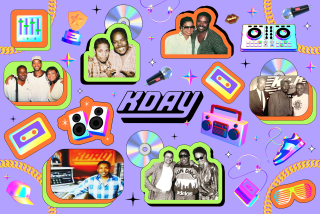Wave Gets Voice, Flows Into the Mainstream
- Share via
There’s a new Wave on Los Angeles radio today.
The original version of the Wave programming--launched with great fanfare and considerable controversy in February, 1987--featured no live announcers, a radically different playlist of New Age, lite jazz and soft R&B;, and occasional little comedic exchanges between the music selections.
But the new Wave--aired not only locally on KTWV-FM (94.7) but also nationally, via the Satellite Music Network--re-installs live announcers, concert promotions and a slightly more mainstream musical patina.
The programming accent is still on moody stress reduction, but it’s New Age radio with a human voice, according to KTWV’s new program director, John Sebastian.
“I think the originators of the Wave format (primarily former KTWV program director Frank Cody) shortchanged the human side of the listener” for the sake of the concept, Sebastian said.
Among the obstacles thrown up at the listener by the old Wave format were: No identification of musical selections, “playlets” that many listeners mistook for commercials, and the lack of live, human voices on air. KTWV’s ratings have been anemic.
“It was a pretty chilly format, no question,” commented Jerry Del Colliano, editor of the trade publication Inside Radio. “Cody tried to do something different, and he should be saluted. But it was time for an evolution.”
Executives at Satellite Music Network came to the same conclusions, even though KTWV no longer sets the programming agenda for it and other Wave-formatted stations.
Lee Roy Hansen, operations manager at SMN, said he already has begun introducing live announcers--” not deejays,” he stressed--into the network’s format.
“I kept saying, ‘We’ve got to connect more with the audience,’ ” Hansen recalled. “We had to identify the music and build a warmer on-air system without resorting to mindless chatter, which was the thing we’ve always tried to avoid. And all the stations (Wave outlets in San Francisco, Miami, Chicago and other cities) kept finding that announcers were really necessary after all.”
That tallied with the view of Sebastian, who helped create the adult contemporary format and who has long preferred emphasizing contact between a station and its audience by the use of live announcers. In place at KTWV since Aug. 22, his mandate is to splice his format preferences onto the Wave’s.
“I’m calling the format ‘new progressive,’ ” Sebastian said. “I’m trying to pick up where progressive rock in the 1970s left off, and to move away from the light jazz and R&B; content. Nor does this rule out playing new stuff by Genesis or Pink Floyd, or what-have-you. Just so long as it’s not too hard.”
But Sebastian said the new Wave won’t be afraid to be aggressive in other areas, such as breaking new musical talent, promoting local concerts and, in general, targeting young (25-44), urban professional types.
“We’re not going to insult these people’s intelligence,” Sebastian said. “That’s why the live announcers are not going to be intrusive deejay types; there are never going to be insulting, screaming, egocentric ‘personalities’ on KTWV.”
“The whole direction now is toward communicative, friendly deejays,” Del Colliano said. “In that way, the Wave format is leading the way with these moves.”
Not surprisingly, New Age record companies are pleased with the Wave format changes: Their performers and other hard-to-break talent will get a sizable boost from on-air identifications.
“This is the step we were waiting for,” said Rich Schmidt, national promotion director for Windham Hill Records, among the pioneers of New Age labels. “It’s great for everybody: Us, the stations and the artists.”
“It’s a huge help to the listener and the industry,” echoed Columbia promotions director Sheila Chlanda.
“I’m still getting champagne and flowers over the decision,” Sebastian quipped.
The only thing uncertain about the new Wave is whether more listeners will catch it.
“You can’t tell what will work over a year, two years,” Del Colliano cautioned. “Trends die fast. And remember--everyone will tell you this--the L.A. radio market is very different and changeable. You can only predict so far.”
More to Read
The biggest entertainment stories
Get our big stories about Hollywood, film, television, music, arts, culture and more right in your inbox as soon as they publish.
You may occasionally receive promotional content from the Los Angeles Times.










